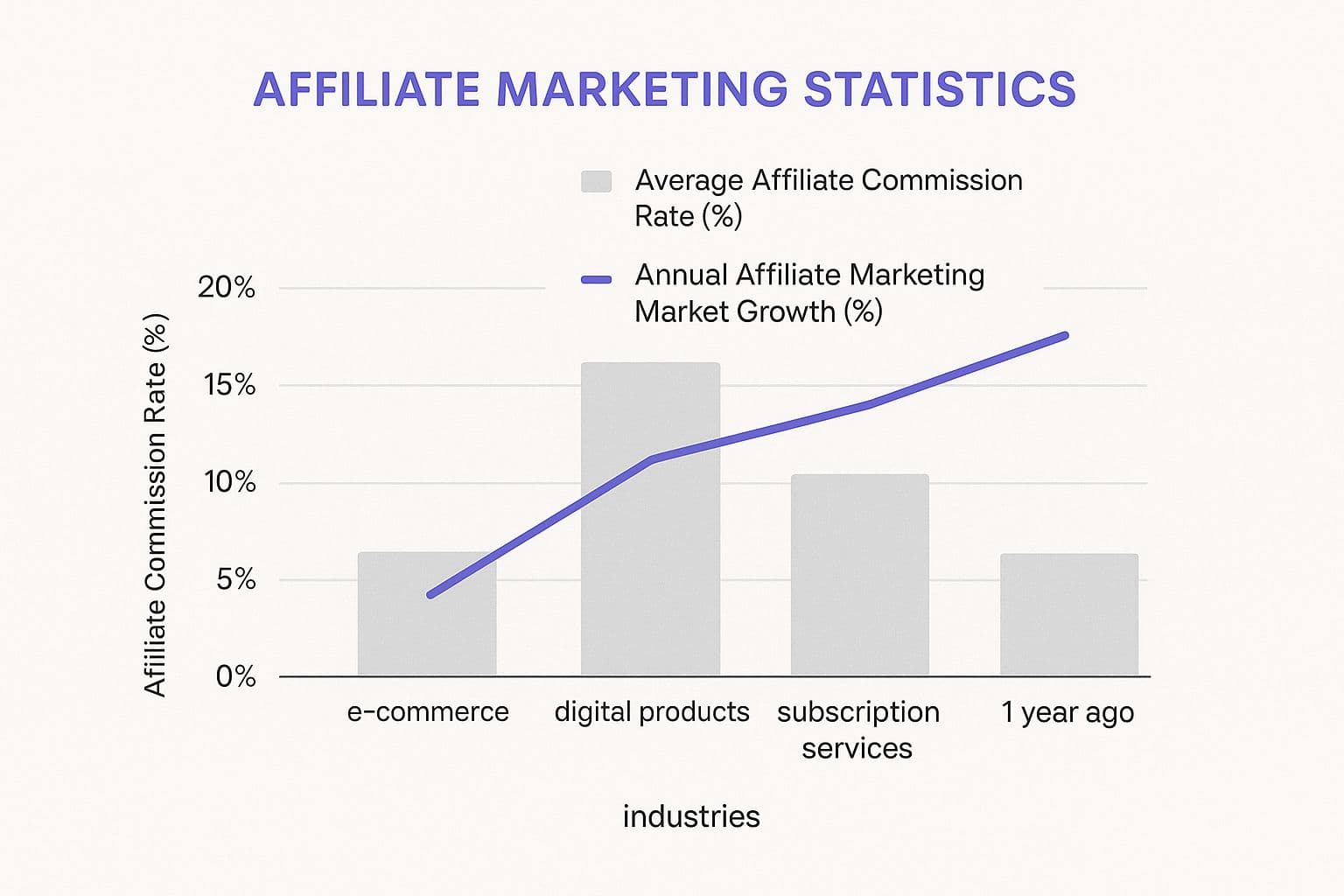How to Recruit Affiliates and Build a Top Program

Before you even think about sending that first outreach email, you need to step back and look at your program from a potential partner's perspective. The secret to effective affiliate recruitment isn't just a numbers game; it's about building a program that top partners genuinely want to join.
This is about more than just a commission check. It’s about creating a framework that feels like a true partnership, one that offers a clear path to success from day one.
How to Build an Affiliate Program Top Partners Actually Want to Join
High-performing affiliates are savvy. They get pitched constantly, so they’ve learned to be selective. They're looking for programs that are well-organized, trustworthy, and set up for mutual success. A simple commission offer just won't cut it in today's market.
The foundation you lay right now directly impacts the quality of partners you'll attract down the road. This means getting a few core components right before you launch.
Set a Competitive and Motivating Commission Structure
Your commission rate is the first thing a potential affiliate will look at. If it’s too low, they’ll scroll right past. If it’s unsustainably high, you’ll torch your profit margins.
Finding that sweet spot requires a bit of homework. Start by researching what your direct competitors are offering. If the industry standard is a 15% commission, offering 5% is a non-starter.
To make your program more appealing, implement these actionable strategies:
- Performance Tiers: Don't just set a flat rate. Offer a baseline commission (e.g., 20%) that increases once an affiliate hits a specific sales threshold (e.g., 25% for 10+ sales/month). This directly rewards your top performers and motivates others.
- Cookie Duration: Offer a 60 or 90-day cookie window instead of the standard 30 days. This is a powerful selling point as it gives affiliates a much better chance of getting credit for sales that don't happen immediately.
- Recurring Commissions: For subscription businesses, this is non-negotiable. Offer affiliates a recurring commission (e.g., 20% for the first year of a customer's subscription) to provide them with stable, predictable income. This is a game-changer for attracting high-value partners.
This chart gives you a sense of what's typical across different industries and shows just how much the affiliate world is growing.

The data makes it clear: while rates vary, the overall market is expanding fast, making it a fantastic channel for both brands and partners.
Craft Clear Program Terms and Provide Essential Assets
Trust is everything in affiliate marketing. Vague or hidden program terms are an immediate red flag. Your affiliate agreement must be easy to find, read, and understand.
To help you structure a program that attracts top talent, here’s a breakdown of the key elements and why they matter.
Key Elements of an Attractive Affiliate Program
| Component | Why It Matters for Recruitment | Actionable Tip |
|---|---|---|
| Competitive Commissions | This is the primary motivator and the first thing potential partners look at. | Research competitor rates and consider performance tiers or recurring commissions to stand out. |
| Clear, Fair Terms | Builds trust and shows you're a professional, reliable partner. | Clearly outline payment schedules, cookie policies, and promotion rules. Avoid jargon. |
| High-Quality Assets | Makes it easy for affiliates to start promoting you immediately. | Create a library with logos, banners, pre-written copy, and high-res product photos. |
| Reliable Tracking Software | Partners need to trust that their sales are being tracked accurately. | Choose a reputable platform that offers a transparent dashboard for affiliates to monitor their performance. |
These elements work together to create an offer that feels professional, fair, and ready for business. Get them right, and you'll find recruitment becomes much, much easier.
Your program’s terms and conditions are more than just a legal document; they are a statement of your company's commitment to a fair and transparent partnership. Clearly define payment schedules, cookie policies, and rules of promotion to build immediate trust.
Beyond legal terms, you must give affiliates the tools they need to succeed. A well-stocked asset library is a sign of a serious program. The easier you make it for them, the faster they’ll start driving results.
If you're looking for inspiration, it's always a good idea to see how established brands do it. Take a look at an example of an affiliate program to see how they present their terms and support their partners.
This market isn't just growing; it's absolutely booming. The global affiliate marketing industry is projected to jump from $18.5 billion in 2025 to $31.7 billion by 2031. This explosive growth is because it works—affiliate marketing already influences about 16% of all e-commerce sales.
For a deeper look into structuring these crucial pieces, our complete guide on building an affiliate program has you covered.
Finding and Vetting Your Ideal Affiliate Partners

Now that you've built an attractive affiliate program, it's time to find the right people to join it. Successful recruitment is about precision, not casting a wide net.
Your mission is to pinpoint partners whose audience and voice genuinely sync up with your product. This isn’t about just finding anyone with a website; it’s about recruiting true brand advocates.
Uncovering Hidden Gems Where Your Audience Lives
The best affiliates are the people your target customers already trust. Your job is to find them. Here’s how to start your search:
- Analyze Your Competition: Use an SEO tool like Ahrefs or Semrush to see which blogs and websites link to your competitors' affiliate programs. These are your warmest leads.
- Explore Niche Communities: Actively participate in Subreddits, Facebook Groups, and Slack/Discord channels relevant to your industry. Identify the influential creators and moderators in these spaces.
- Search Content Platforms: Use specific search queries on YouTube, TikTok, and Google like "[your product category] review" or "how to solve [customer problem]". Look for creators producing high-quality, helpful content.
- Listen to Podcasts and Newsletters: Identify hosts and writers who have built deep trust with your target audience. A single mention from them can be incredibly powerful.
A Framework for Vetting Potential Partners
Finding a potential affiliate is just the first step. Vetting separates a high-performing program from one plagued by junk traffic. You need a consistent framework to evaluate every candidate.
The focus should be on authenticity and engagement, not just vanity metrics. A micro-influencer with 5,000 hyper-engaged followers is infinitely more valuable than a generalist with 500,000 uninterested ones.
The single most important question to ask is this: "Does this partner's content add real, tangible value to their audience?" If the answer is a clear yes, you've likely found a great fit. If their platform is just a jumble of affiliate links, it’s a massive red flag.
When you're sizing up a potential partner, use this checklist:
- Content Quality and Consistency: Is their work well-researched and regularly updated?
- Audience Engagement: Are people leaving thoughtful comments and asking smart questions? Look beyond likes.
- Traffic Sources and Authenticity: Do their traffic numbers seem legitimate? Beware of sudden spikes or spammy SEO tactics.
- Brand Alignment: Do their values and voice match yours? Avoid partners who could damage your brand's reputation.
This entire process is really just a specialized form of lead generation, where your "leads" are potential partners. To get better at this, it helps to understand various proven lead generation strategies which can dramatically expand your pool of quality candidates.
Crafting Outreach That Actually Gets a Response

Top-tier affiliates are inundated with generic partnership requests. To break through the noise, your outreach must be personal and valuable from the very first line.
The Anatomy of a High-Converting Recruitment Email
The goal is to make a real connection, not just blast out emails. Think of your email as a conversation starter between two professionals.
Writing a Subject Line That Commands Attention
Your subject line determines whether your email gets opened or deleted. Be specific, intriguing, and personal. Avoid generic clickbait like "Quick Question" or "An amazing opportunity."
Here are subject line templates that work:
- Reference Their Work: "Loved your review of [Competitor Product]"
- Show a Clear Benefit: "Partnership idea for the [Their Audience Name] community"
- Be Direct and Professional: "Partnership opportunity with [Your Brand]"
Personalization Is Your Superpower
This is the most critical part of recruiting good affiliates. Show that you see them as a unique creator. Vague compliments like "I love your blog" are meaningless.
Get specific. Reference a particular article, a point from a video, or a recent podcast episode.
Here’s what that looks like in the wild:
"Hi Alex, I just finished your YouTube video comparing different project management tools. Your breakdown of task dependencies was incredibly clear—it’s an area where most reviews fall short. It got me thinking you might be interested in our platform, Push Lap Growth."
An opener like that proves you’ve done your homework and builds instant rapport.
Articulating Your Value and Making It Easy to Say Yes
Once you have their attention, get to the point. Frame the proposition around how promoting your product will benefit their audience and their business.
A solid outreach email follows this four-part structure:
- The Specific Compliment: Start with your genuine, personalized reference.
- The Bridge: Connect their content directly to your product. "Since your audience is focused on scaling their SaaS, our affiliate management tools could be a perfect fit."
- The Core Offer: Be upfront about your commission rate, cookie duration, and key perks like recurring commissions.
- The Clear Call-to-Action: Tell them exactly what to do next. "If this sounds interesting, here’s a link to our affiliate landing page with all the details."
Following Up Without Being a Pest
Even a perfect email can get missed. A polite, strategic follow-up is often necessary. Wait 3-5 business days before sending a friendly nudge.
Your follow-up should be short and direct. "Hi Alex, just wanted to follow up on my email from last week about a potential partnership. Let me know if you have any questions!" That's it. If you don't hear back after two or three attempts, move on.
Your Affiliate Onboarding and Activation Playbook

Getting a "yes" is the starting line. The real work is activation. A clunky onboarding process is where promising partnerships die.
The goal is to remove every bit of friction so your new partner can start promoting you immediately. A smooth onboarding experience dramatically shortens the time to their first sale.
Crafting a Flawless Welcome Experience
The moment an affiliate is approved, the clock starts ticking. Your first welcome email must provide immediate value and a clear path forward.
Your initial welcome email should be a complete starter kit, including:
- Immediate Access: Provide their unique affiliate tracking link and login details for the dashboard upfront. Don't make them dig.
- Quick-Start Guide: Link to a one-page PDF or a short 2-minute video that explains how to find links, access assets, and read the dashboard.
- Dedicated Support Contact: Give them a direct email for affiliate support, showing a real person is there to help.
- Link to Terms: Include a direct link to the affiliate agreement for easy reference.
Arming Your Partners for Immediate Action
Never make your affiliates hunt for resources. A well-organized, self-service resource library is non-negotiable.
The entire philosophy of affiliate activation boils down to one simple idea: remove every obstacle between your partner and their first promotion. If they have to email you for a logo or ask where to find email copy, you've already introduced friction.
Make sure your resource library is easily accessible from their dashboard and clearly organized.
The Essential Affiliate Toolkit
| Asset Type | Why It's Crucial for Fast Activation |
|---|---|
| Logos & Banners | Gives them official brand images in all the standard sizes for website sidebars, blog posts, and ads. |
| Product Images | High-quality photos and lifestyle shots let affiliates create authentic content that connects with their audience. |
| Email Swipe Copy | Pre-written email templates give partners a huge head start for promoting to their email lists—often their best-converting channel. |
| Social Media Posts | Ready-to-go captions and images for platforms like X, LinkedIn, or Facebook take the content creation burden off their shoulders. |
Putting in this work upfront shows you're a serious partner who is invested in their success. It builds their confidence and gives them the practical tools they need to get started. For affiliates who are new to the game, these operational details are everything. In fact, you can see the bigger picture by exploring our guide on how to start an affiliate marketing business for a full breakdown.
By setting them up for success from day one, you’re not just onboarding someone new—you’re activating a true business partner.
Scaling Recruitment with the Right Tools and Tactics
https://www.youtube.com/embed/JJHPMam8-6I
Manual outreach is great for your first few affiliates, but it doesn't scale. To build a program that drives real revenue, you need to transition from manual hustling to a systematic recruitment engine.
This is where you use technology to find affiliates, manage outreach, and turn your own website into a passive recruiting tool.
Leverage Affiliate Discovery Platforms and CRMs
Manually searching Google and social media will eventually hit a wall. Affiliate discovery platforms and marketplaces are specialized search engines for finding top performers. They provide a pre-vetted pool of partners that you can filter by niche, audience size, and track record, saving you countless hours.
Once you identify potential affiliates, a spreadsheet quickly becomes a mess. Use a Customer Relationship Management (CRM) tool to track your outreach systematically. A CRM helps you track:
- Who you've contacted: Avoid duplicate outreach.
- Follow-up schedules: Set reminders so prospects don't fall through the cracks.
- Performance data: Trace a successful partner back to your recruitment efforts.
The real leap in affiliate recruitment happens when you stop thinking in terms of individual emails and start thinking in terms of a scalable system. Technology isn't just about being more efficient; it’s about creating a predictable pipeline of new partners.
Turn Your Website into a Recruitment Hub
Your own website is a powerful but often overlooked recruitment asset. Don't hide the "Affiliates" link in your footer. Create a prominent, well-designed affiliate landing page to turn site traffic into a steady stream of new partners.
Treat this page like a sales page for your partnership. It must immediately answer these questions:
- "What’s in it for me?" Display your commission rate, cookie duration, and perks like recurring payouts upfront.
- "Is this a good fit for my audience?" Clearly explain what your product does and who it helps.
- "Is this program legit?" Build trust with testimonials from current partners and a simple sign-up process.
This approach filters for affiliates already interested in your brand, leading to higher-quality sign-ups with less effort.
Tap into Established Affiliate Networks
For a shortcut to growth, join an established affiliate network like ShareASale or CJ Affiliate. These platforms offer immediate access to thousands of active affiliates seeking new programs.
However, this access comes at a price. Weigh the pros and cons carefully.
Weighing the Benefits and Drawbacks of Networks
| Pros of Using a Network | Cons of Using a Network |
|---|---|
| Instant Access: Plug into a massive, existing pool of vetted affiliates. | Network Fees: Expect to pay setup fees, monthly costs, and a cut of every commission. |
| Simplified Management: Networks handle all the technical heavy lifting like tracking, reporting, and payments. | Less Control: You have less direct influence over your brand and partner relationships. |
| Increased Trust: Affiliates trust the third-party tracking and reliable payment systems of major networks. | Increased Competition: Your program is listed right alongside thousands of others, all vying for attention. |
A hybrid model often works best: use a network for initial growth while building a private, in-house program to nurture your top-performing partners.
Incentivize Referrals from Your Best Partners
Your best affiliates are your most credible recruitment tool. They understand your product's value and know other creators in their niche.
Implement a formal affiliate referral program to turn partners into a proactive recruitment team. Offer a cash bonus or a percentage of a new affiliate's earnings for their first few months. This creates a powerful, self-sustaining loop where great partners bring you more great partners.
This is exactly the kind of sophisticated strategy that’s being funded by growing budgets in the industry. In fact, U.S. affiliate marketing spending is projected to hit nearly $12 billion by 2025—a 65% jump in just five years from 2023. This explosion in spending is fueling more advanced recruitment and retention tactics like these. You can dig deeper into these trends in a report on affiliate marketing statistics from Wix.com.
Common Questions About Recruiting Affiliates
Getting a handle on these common questions early on will save you headaches and start your program on the right foot.
Let’s dive into the real-world decisions you'll be making as you build your partnerships.
How Much Should I Pay My Affiliates?
The "right" commission is a balance between attracting great partners and maintaining profitability. While there's no magic number, industry norms provide a solid starting point.
- Physical Products: Rates typically range from 10-20%.
- Digital/SaaS Products: With lower overhead, commissions of 20-50% are common and competitive.
Don't stick to a single flat rate. Implement a tiered structure to motivate performance. For example, offer a base commission of 20%, increasing to 25% for any affiliate driving over 50 sales in a month. This incentivizes your best partners to promote your brand more heavily. The goal is to be competitive enough to recruit and profitable enough to sustain.
Should I Use an Affiliate Network or Go In-House?
This is the classic fork in the road. Each path has clear pros and cons.
-
Affiliate Networks (e.g., ShareASale, CJ Affiliate): These are ideal for rapid launch. You get immediate access to a large pool of affiliates and they handle all technical aspects like tracking and payments. The downside: network fees and less direct control over your brand and partner relationships.
-
In-House Programs (using dedicated software): Going in-house gives you complete control, allows for direct relationships with partners, and avoids network fees. The downside: all work—recruitment, management, and technical setup—is your responsibility.
Many brands adopt a hybrid model: launch on a network for initial momentum, then build a private in-house program to nurture top performers. This is a crucial element of effective affiliate marketing program management, giving you the flexibility to adapt as you grow.
The biggest mistake I see is treating recruitment like a one-and-done task. It’s a constant, ongoing process. You're always looking for, vetting, and activating new partners. Remember, quality will always crush quantity. Ten truly engaged affiliates will outperform 100 inactive ones every single time.
What Are the Biggest Recruitment Mistakes to Avoid?
Knowing what not to do is just as valuable. Sidestep these common traps to stay ahead.
- Sending Generic Outreach: Nothing gets your email deleted faster than a generic, copy-paste message. High-value affiliates can spot them from a mile away.
- Skipping the Vetting Process: Onboarding just anyone who applies is a recipe for disaster. Low-quality or fraudulent partners can tarnish your brand and drain your resources.
- Having a Weak Onboarding Flow: If your sign-up and setup process is confusing or clunky, your new affiliates will never get started. That's potential revenue just sitting on the table.
- Neglecting Partner Support: If you don't provide great creative assets and timely help, you’re making it incredibly difficult for your partners to succeed.
At the end of the day, it all comes down to treating your affiliates like true business partners. If you focus on building quality relationships and giving them the tools and support they need, the results will naturally follow.
Ready to build, manage, and scale your affiliate program without the complexity? Push Lap Growth provides all the tools you need—from a fully branded portal and automated payouts to a marketplace of qualified affiliates. Start your 14-day free trial and see how easy it is to accelerate your revenue through partnerships.